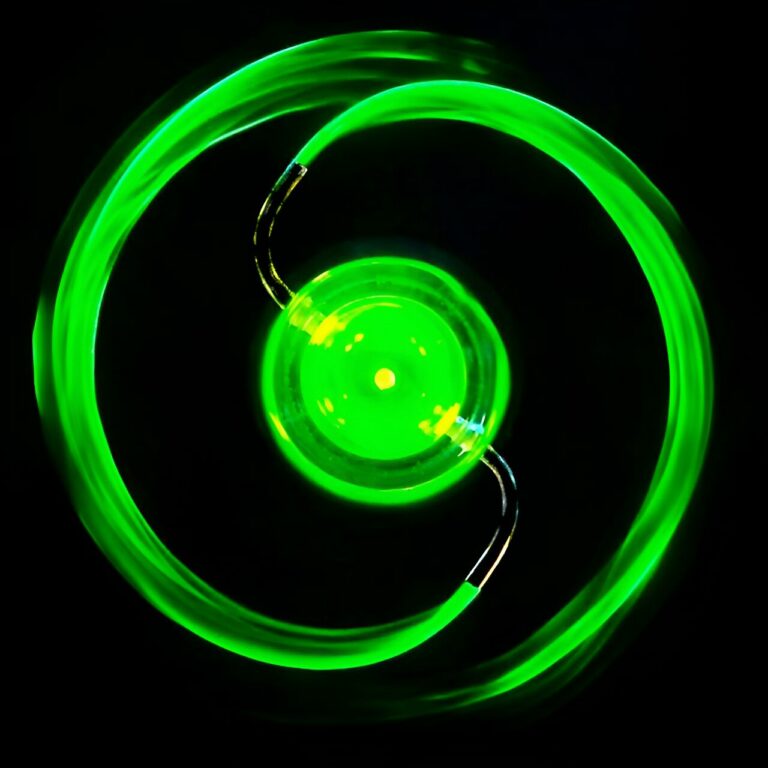Decades-Old Physics Puzzle Solved: Unraveling the Mechanism Behind the ‘Reverse Sprinkler’
Decades of scientific inquiry have been dedicated to unraveling the enigma known as Feynman’s Sprinkler Problem: How does a sprinkler function in reverse, with water flowing into the device instead of out? Through a series of meticulous experiments, a team of mathematicians has successfully deciphered the intricate mechanics of fluid dynamics and shed light on this longstanding mystery.
Leif Ristroph, an associate professor at New York University’s Courant Institute of Mathematical Sciences and the senior author of the research paper published in the journal Physical Review Letters, elucidates, “Our study tackles this problem by combining precise laboratory experiments with mathematical modeling, providing an explanation for the operation of a reverse sprinkler.”
The team’s findings reveal that when water is drawn into the reverse sprinkler, it spins in the opposite direction to when it expels water. The cause behind this phenomenon is both subtle and surprising.
Ristroph further explains, “While a regular or ‘forward’ sprinkler resembles a rocket, propelling itself by expelling jets of water, the reverse sprinkler is shrouded in mystery as the water being drawn in does not resemble jets at all. However, we have discovered that the secret lies within the sprinkler itself, where hidden jets account for the observed motions.”
This research not only solves one of the most challenging problems in fluid physics but also provides valuable insights into the underlying principles. Although Ristroph acknowledges that understanding the inner workings of a reverse sprinkler may have limited practical applications, stating, “There is no need to ‘unwater’ lawns,” the findings contribute to our knowledge of physics and may aid in the improvement of devices that utilize flowing fluids to control forces and motions.
Brennan Sprinkle, a co-author of the paper and an assistant professor at Colorado School of Mines, highlights that our understanding of the relationship between fluid flow through structures and induced motion has significantly improved. The methods employed in our experiments are believed to have practical applications in various devices that respond to the movement of air or water.
The Feynman sprinkler problem is commonly presented as a hypothetical scenario involving a lawn sprinkler that spins when fluid, such as water, is expelled from its S-shaped tubes or “arms.” The question posed is what would occur if fluid were to be drawn in through the arms: Would the device rotate, in which direction, and why?

The issue is connected to pioneers in the field of physics, starting from Ernst Mach, who first presented the problem in the 1880s, to the renowned Nobel laureate Richard Feynman, who extensively researched and popularized it from the 1960s to the 1980s. Since then, numerous studies have been conducted, debating the outcome and the underlying physics. Even today, it remains an unresolved problem in the field of physics and is included as such in textbooks on fluid mechanics.
In order to tackle the reverse sprinkler problem, Ristroph, Sprinkle, and their colleagues, including Kaizhe Wang, a doctoral student at NYU during the study, and Mingxuan Zuo, a graduate student at NYU, developed custom-made sprinkler devices. These devices were then immersed in water within an apparatus that allowed for controlled rates of water inflow or outflow.
To enable the device to spin freely in response to the water flow, the researchers created a new type of ultra-low-friction rotary bearing. Additionally, they designed the sprinkler in a manner that allowed them to observe and measure the water flow both inside and outside of it.
“This approach had never been attempted before and played a crucial role in solving the problem,” explains Ristroph.
To enhance their observation of the reverse sprinkler process, the researchers introduced dyes and microparticles into the water. They then used lasers to illuminate the flow and high-speed cameras to capture the movements.
The results revealed that a reverse sprinkler rotates at a significantly slower speed compared to a conventional one—approximately 50 times slower. However, the underlying mechanisms are fundamentally similar.
A conventional forward sprinkler functions like a spinning rocket propelled by water shooting out from its arms. On the other hand, a reverse sprinkler operates as an “inside-out rocket,” with its jets directed inward towards the chamber where the arms intersect. The researchers discovered that the two internal jets collide, albeit not directly head-on, and their mathematical model demonstrated how this subtle interaction generates forces that cause the sprinkler to rotate in the opposite direction.
The team perceives this breakthrough as potentially advantageous in harnessing energy sources that are environmentally friendly.
“Numerous and sustainable energy sources surround us, such as wind in the atmosphere and waves and currents in oceans and rivers,” explains Ristroph. “Finding ways to tap into this energy is a significant challenge that necessitates a deeper understanding of fluid physics.”
This article is republished from PhysORG under a Creative Commons license. Read the original article.
Do not forget to share your opinion with us to provide you with the best posts !




0 Comments